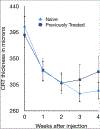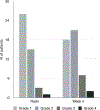Nonresponders to Ranibizumab Anti-VEGF Treatment Are Actually Short-term Responders: A Prospective Spectral-Domain OCT Study
- PMID: 31937473
- PMCID: PMC7416963
- DOI: 10.1016/j.oret.2019.11.004
Nonresponders to Ranibizumab Anti-VEGF Treatment Are Actually Short-term Responders: A Prospective Spectral-Domain OCT Study
Abstract
Purpose: To investigate the inter-individual variability in duration of anti-vascular endothelial growth factor (VEGF) treatment effect in neovascular age-related macular degeneration (nvAMD).
Design: Prospective observational multi-centered study.
Participants: Forty-eight patients with nvAMD treated with anti-VEGF injections were included. Both treatment naive (n=25) as well as patients who had previously received treatment with ranibizumab (n=23) more than one month prior to their enrollment were recruited.
Methods: Patients received injection with ranibizumab (0.5 mg/0.05 ml) and were followed weekly for 4 weeks with spectral-domain OCT (SD-OCT) assessing the time to maximal reduction of central retinal thickness (CRT) and the presence of intraretinal and subretinal fluid. Other data collected included age, gender, visual acuity, axial length, lens status, and previous injections. The Shapiro-Wilk test was used to examine normal distributions for all variables. Correlations were examined by calculating Spearman's correlation coeficient. Distributions of quantitative variables are described as means (±SD). Qualitative variables are summarized by counts and percentage.
Main outcome measures: Time to maximal reduction of CRT and intra- and subretinal fluid after ranibizumab injection.
Results: A total of 48 eyes of 48 patients (age 74.8±8.3 years, 62.5% female, 52% treatment naive, 35.4% pseudophakic) were assessed. Two-thirds (64.6%) reached maximal CRT reduction earlier than the standard 4-week interval: 6.3% at 1 week postinjection, 22.9% at 2 weeks postinjection, and 35.4% at 3 weeks postinjection. Only 35.4% of patients had maximal CRT reduction at 4 weeks. Twenty percent of treatment-naive and 34.8% of non-naive patients had a week-4 CRT that was >35 μm thicker than the earlier occuring lowest CRT value (nadir). The time to maximal CRT reduction was not related to axial length, age, lens status, or history of injections.
Conclusions: Optimal dosing interval for maximal CRT reduction may be less than 4 weeks for a significant proportion of patients. Most patients will be classified as complete responders if intervals less than 4 weeks are used to assess anti-VEGF treatment response. Disease load rather than eye size appears to be the driver of anti-VEGF treatment duration and therefore, dosing interval needs to be optimized in the cohort of short-term responders.
Copyright © 2019 American Academy of Ophthalmology. Published by Elsevier Inc. All rights reserved.
Figures




Comment in
-
Re: Bontzos et al.: Nonresponders to Ranibizumab Anti-VEGF Treatment Are Actually Short-term Responders: A Prospective Spectral-Domain OCT Study (Ophthalmol Retina. 2020;4:1138-1145).Ophthalmol Retina. 2021 Mar;5(3):e3. doi: 10.1016/j.oret.2020.11.013. Ophthalmol Retina. 2021. PMID: 33678431 No abstract available.
-
Reply.Ophthalmol Retina. 2021 Mar;5(3):e4. doi: 10.1016/j.oret.2020.11.014. Ophthalmol Retina. 2021. PMID: 33678432 No abstract available.
References
-
- Brown DM, Kaiser PK, Michels M, et al., Ranibizumab versus verteporfin for neovascular age-related macular degeneration. N Engl J Med. 2006;355:1432–1444 - PubMed
-
- Brown DM, Kaiser PK, Michels M, et al. Ranibizumab versus verteporfin photodynamic therapy for neovascular age-related macular degeneration: Two-year results of the ANCHOR study.Ophthalmology. 2009;116:57–65. - PubMed
-
- Rosenfeld PJ, Brown DM, Heier JS, et al., Ranibizumab for neovascular age-related macular degeneration. N Engl J Med. 2006;355:1419–1431. - PubMed
Publication types
MeSH terms
Substances
Grants and funding
LinkOut - more resources
Full Text Sources
Research Materials

